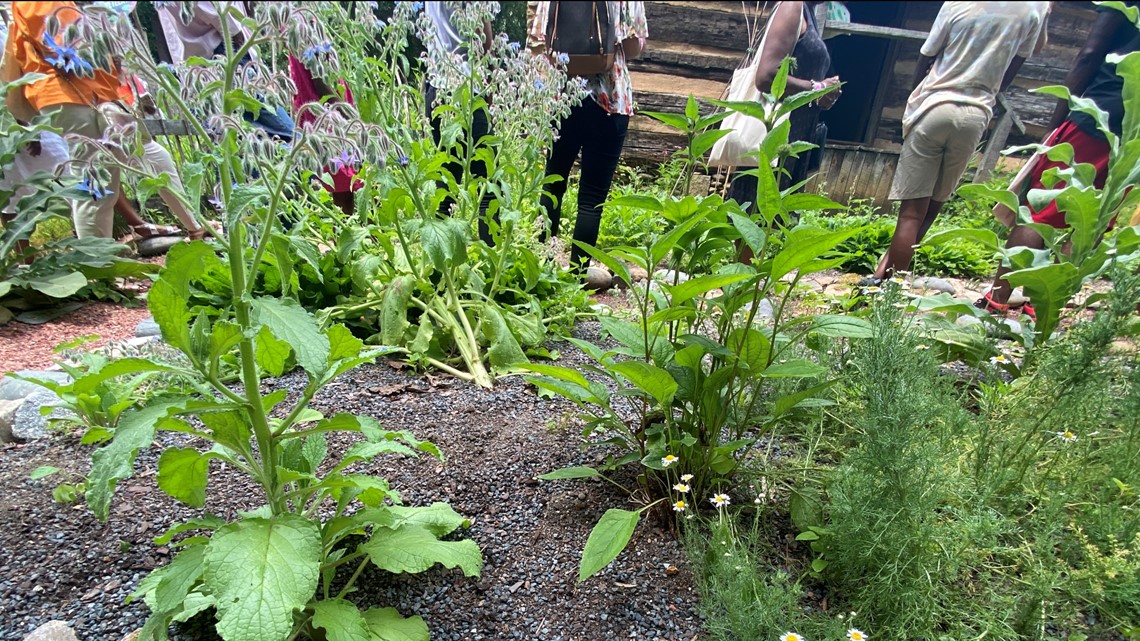ATLANTA — As the nation partakes in a celebration of freedom, people can mark liberation by literally planting a seed.
June 19, 1865, or Juneteenth, marks the day the last of the enslaved in the Confederacy learned they were freed due to the Emancipation Proclamation. Now the federally recognized holiday commemorates the end of the institution of slavery in the United States.
For the nearly four million enslaved African Americans, life shifted drastically. But one thing that held true was the knowledge of how to care for land -- and their practices that made it overseas and through hundreds of years.
Much of this can be seen in a freedom garden -- an example that the Atlanta History Center has recreated in its emancipation garden, and a journey they encourage others to take.
Significance of an emancipation garden
"We do our very best to interpret what kind of plants they would have grown, the kind of the shape of it, the style of beds, all that kind of stuff," Michael Dreyer, the center's horticulturist said. "These gardens would have been heavy (with) medicinal plants. This is primarily because during enslavement, the medical care would have been completely lacking, to say the least."
Dreyer explains that such gardens hold historic significance.
Pre-emancipation, gardens were a way for the enslaved to grow their medicinal herbs and crops to add nutrition to their meals. It was ultimately a way to care for themselves. Post-emancipation, the gardens were a symbol of power, a piece of land that displayed a semblance of economic freedom. Today, an emancipation garden is a way to feel tied to one's roots and understand the historic significance of agricultural practices that survived generations.
"They formed the basis of what we think of today as Southern cooking," Dreyer said. "The vast majority of what we think of today as Southern cooking really comes from the traditions of West African people who (were) enslaved here in America."


Okra, sweet potatoes, peanuts, watermelon -- all foods that were grown by enslaved people to keep themselves fed. Post-emancipation, newly liberated African Americans also incorporated black-eyed peas into their gardens.
"During the kind of the early years of Reconstruction, most of the formerly enslaved went through intense economic hardship," Dreyer explained. "The black-eyed peas or the cowpea was an extremely reliable crop that was a rich protein source that could be made into all kinds of foods and it would be grown."
As people observe Juneteenth, it's almost impossible to ignore the agricultural ingenuity and cultural significance that is behind the food many enjoy today, Dreyer explained. More important, though, is understanding what a successful garden meant.
"This enormous population of peoples that were forcibly enslaved, who made the Southern United States and the United States as a whole, for that matter, economically incredibly powerful," Dreyer said. "All that land that they worked and they worked to make so profitable, they were, or at least the vast majority of folks, received no ownership of."
With emancipation, many African Americans were free to grow what they want, which paved a path for the formerly enslaved to have agency in their own life.
"And so when you think about these gardens, I think that land is power, whether it's cultural power, whether it's economic power, whether it's, you know, self-sufficiency," he said.
How to start your own emancipation garden
After learning about the history and the significance of an emancipation garden, Dreyer encourages other families to start their own, calling it a family-friendly project.
"Don't overcomplicate it," Dreyer said about getting started. "One of the very first things humans developed was agriculture and we're also capable of it."
He suggests starting via trial and error and having fun with it.
When it comes to what to grow his first suggestion is a southern favorite: okra.
"Okra is one of my favorite vegetables. You can eat it raw, you get it cooked, you can fry it, you can make it in a gumbo," he said. "But it's also beautiful."
As okra is part of the hibiscus family, it can decorate a garden with beautiful flowers while also producing a tasty and versatile vegetable. He also recommended trying to grow black-eyed peas. The peas need a trellis, but after some handiwork, children can visibly see the fruits of their labor.
"In terms of herbs, borage is a fun one," he added. "Borage is an edible flower and it's a beauty. Makes a beautiful, gorgeous blue pollinator-loving flower."


The herb will bring honeybees to the yard and add some new color to it, Dreyer explained. People can also entertain children by letting them take a bite of a petal or two.
After starting with some easy herbs and crops, Dreyer advises people to "grow what you want to grow" and encourages learning about how the seeds got here. Afterall, the crops were planted here, like the people who brought them.
"It's a continuation of cultural heritage," he said." I think these gardens represent a sort of defiance and strength that I think we should really celebrate today."
Dreyer only scratched the surface of what an emancipation garden could look like. For a more in-depth explanation and a list of things to grow, head to the Atlanta History Center's blog post.

